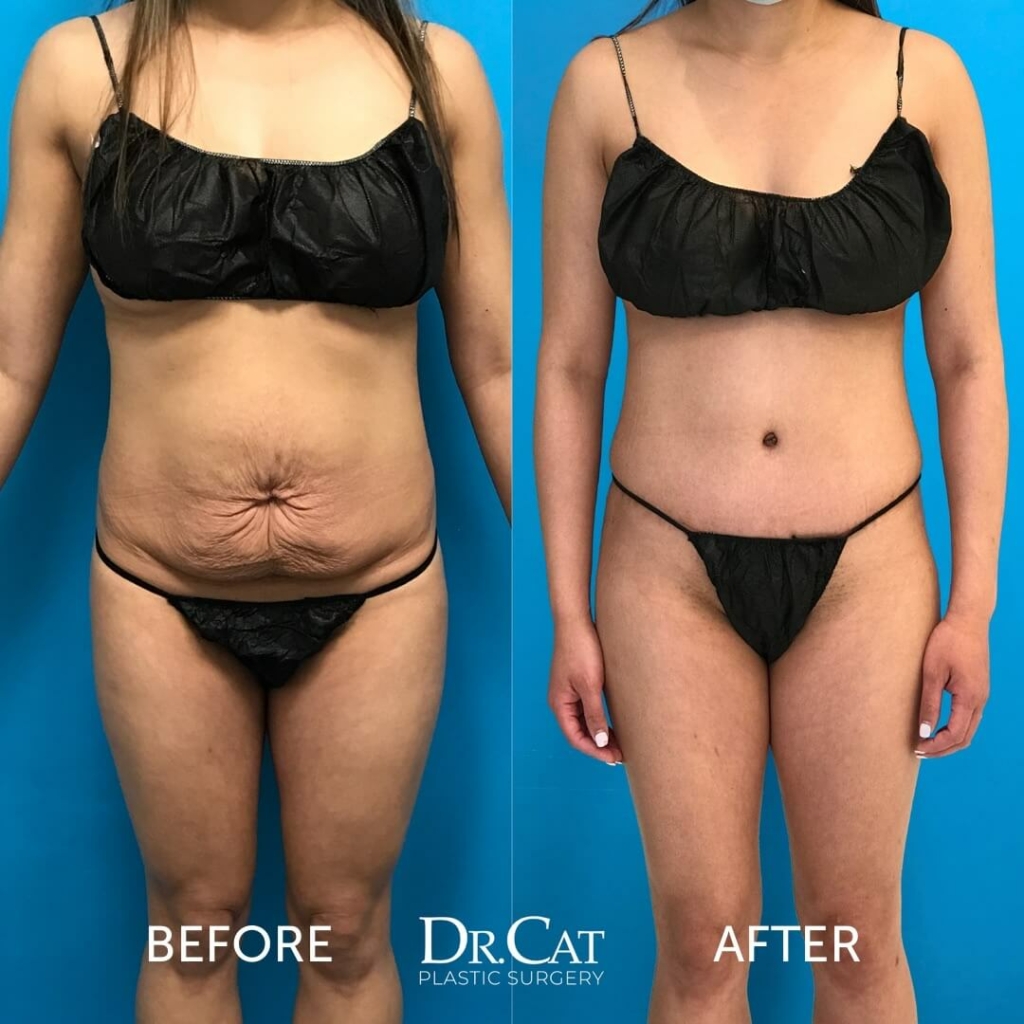Navigating the Challenge of Torn Internal Stitches Post-Tummy Tuck
Ready for your long-awaited tummy tuck? That rollercoaster of emotions you’re experiencing is totally normal.
On the one hand, you’re excited about the sleek, flat tummy, toned muscles, and renewed confidence waiting on the other side. On the other, you might feel a bit anxious about potential complications, like torn internal stitches.
We get it, and if we’re being honest, it’s good to prepare for both the highs and possible lows of any surgical journey. That’s why at Dr. Cat Plastic Surgery, we make it a point to inform patients about every unexpected risk their procedures can present.
The upside? With careful planning, you can curb these risks and lay the foundation for a smooth, successful abdominoplasty.
In today’s article, we take a closer look at internal tummy tuck stitches, how to know when you need surgical stitch repair, and practical tips to reduce tummy tuck complications.
Understanding Tummy Tucks and the Role of Internal Stitches
In case you didn’t already know, a tummy tuck is a cosmetic procedure designed to give you a slimmer, more toned appearance and restore strength in your rectus (or six-pack) muscles, which diminish with pregnancy, drastic weight fluctuations, and natural aging.
Think of this procedure as a two-part repair that removes excess hanging skin or belly fat and corrects abdominal muscle separation (or diastasis recti).
After elevating the abdominal skin, your surgeon works to repair and retighten the abdominal muscles, restoring them to a stronger, more youthful state. They do this by creating an internal, corset-like structure in the abdominal wall, which they then secure with internal stitches. These internal stitches need time to scar into place and hold as intended.

Without these internal sutures, your muscles would fail to stay in their new position, undermining your surgery’s structural integrity and aesthetic goals. Not to mention, it would increase your risk of potential scarring and other tummy tuck complications.
We know what you’re thinking: with the different tummy tuck styles out there (traditional, extended, mini), is there one that foregoes internal stitches?
No matter what type of tummy tuck you receive, internal sutures are probably involved. The only real difference is how extensive they are from one tummy tuck to the next.
As for what causes internal stitches to come undone…
Factors Leading to Torn Internal Stitches
The good news is that recent studies show tummy tuck safety profiles are on the up and up. That said, it’s still good to know what could cause your internal stitches to tear so you can mitigate potential risks as much as possible.
Here are the most common factors that could lead to the tearing of internal tummy tuck sutures:
Doing too much too soon
If you jump into heavy lifting, strenuous workouts, or any intense physical activity too quickly post-op, you will put undue stress on your delicate internal sutures.
Not adhering to post-operative instructions
Not following your surgeon’s tummy tuck post-operative care guidelines, like failing to wear your compression garments or avoiding certain movements, will undoubtedly increase your risk of suture tearing.
Poor wound healing or infections
Individual healing factors, like your age, overall health, and lifestyle choices (like smoking or vaping), can all affect tissue strength and the integrity of your sutures.
Improper suture material
Your surgeon’s method (and skill) are vital in how well your sutures hold up. In rare cases, the type of suture material they employ might not be ideal for your tissue type or the unique demands of your tummy tuck case.
Poor surgical technique
Dr. Cat Huang-Begovic boasts decades of specialized experience in tummy tucks and abdominal muscle repair—a level of expertise that makes all the difference in the success of your procedure.
So, how do you know if your internal stitches have been compromised?
Signs of Torn Internal Stitches

Knowing how to spot potentially torn internal stitches is a must for timely intervention and healing.
Here are some symptoms of torn stitches you’ll want to look out for:
- Sudden spike of pain in or around your surgical site
- Persistent fever, chills, and exhaustion
- Redness or irritation around your incision
- Unusual swelling or bulging near the surgical site
- Bleeding, fluid discharge, or foul odor
- Tender or swollen lymph nodes
- Feeling a ‘popping’ or that something has snapped or shifted internally
Suspect this is the case? Let’s talk about what happens if it comes to post-tummy tuck emergency care.
What to Do If Internal Tummy Tuck Stitches Come Undone
If you think you might need post-surgical stitch repair, your first step is to get in touch with your surgeon, or better yet, consider consulting a new surgeon for their expertise.
If you wait too long, you could jeopardize the healing process and outcome of your surgery, which is definitely not what we want.
Once you meet with your surgeon and they determine you’re indeed presenting signs of torn internal stitches, they’ll likely schedule you for a revision tummy tuck procedure.
Under anesthesia, your surgeon will reopen your surgical site through the same incisions as your initial procedure (to reduce any further scarring). They’ll carefully examine the internal stitches, assessing the extent of the tear, as well as which approach is best for repair.
Your surgeon removes and replaces the torn sutures, ensuring your abdominal muscles and skin are properly realigned and secured. Depending on the severity and location of your torn stitches, this can be more or less extensive.
After restoring the integrity of your tummy tuck, you’ll receive new abdominoplasty post-care guidelines. From here, it’s time to shift the focus back to recovery.
Tips for Preventing Stitch Tearing Post-Op

Let’s face it—the last thing any patient ever wants to see after surgery is signs of a suboptimal tummy tuck or, worse, encounter complications like undone stitches.
So, is there anything you can do to maximize your abdominoplasty recovery and support healing after stitch-tearing? Absolutely!
Here are some tips to help you keep tummy tuck complications at bay:
- Always adhere to your surgeon’s post-operative care instructions.
- Steer clear of lymphatic massages post-tummy tuck, as Dr. Cat warns they often do more harm than good.
- Drink plenty of water and maintain a healthy diet with foods rich in proteins, vitamins, and minerals to aid tissue repair and recovery.
- Keep up with follow-up appointments to monitor your recovery and promptly address any issues.
- Listen to your body. Pay attention to any signs of complications and contact your provider with any concerns.
Dr. Cat Plastic Surgery: Your Source for Seamless Beauty
The thought of torn internal stitches can be a bit scary, but every surgery has the potential to hit a few snags. One way to calm those nerves? Choose a provider with a stellar track record and years of expertise in tummy tuck surgery.
Dr. Cat has mastered the art of delivering tummy tuck results that blend safety with stunning transformations. Her skill in navigating the nuances of abdominoplasty means your journey toward a new you is truly in the most capable hands.
It’s time to let go of the worries and embrace the enthusiasm of what’s ahead!

